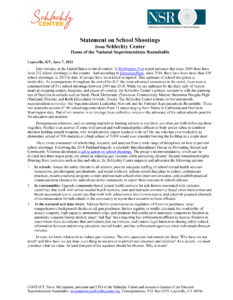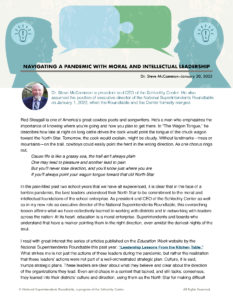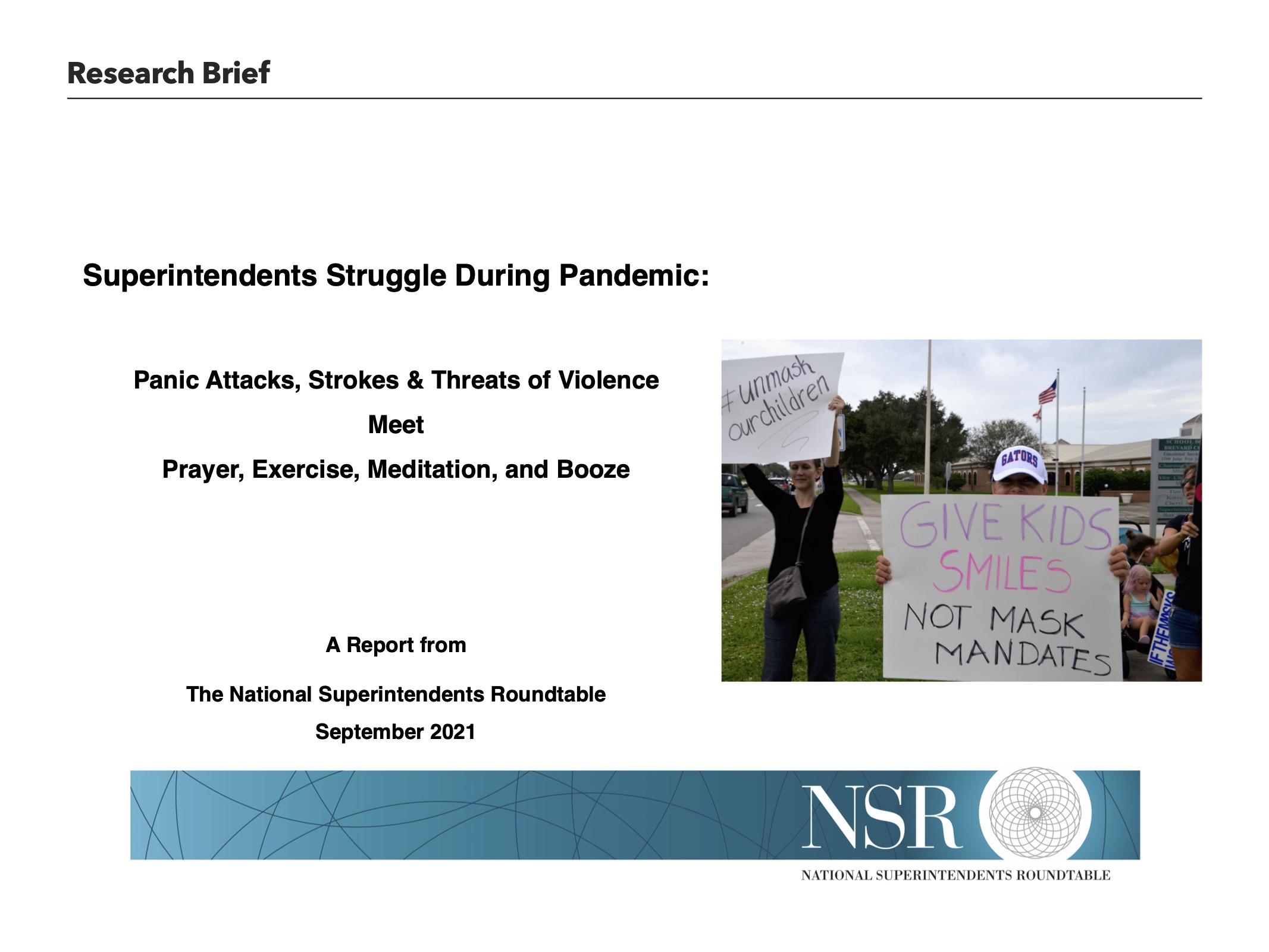To: Research Committee, Committee on Education Funding
From: James Harvey, National Superintendents Roundtable
Subject: Research and Analysis on Early Childhood Education
Date: August 1, 2013
President Obama’s proposal for a $75 billion federal investment (with a required state match) in state pre-K programs has drawn criticism from some quarters about the quality of the research behind the proposal. The Brookings Center’s Grover J. Whitehurst, for example, claims that the administration’s proposal is “not based on sound research,” arguing that “age-cutoff regression discontinuity” studies ask the wrong question. The appropriate question, he says, “is the degree to which the availability of [a] public program changes children’s outcomes compared to business-as-usual for those same children.”
Opponents such as Mr. Whitehurst examine “children’s outcomes” through a very narrow and short-term lens. That lens focuses sharply only on tested achievement and only on the effects on achievement in the first year or first few years of elementary school. It ignores positive short-term findings around family’s parenting skills and children’s health and well being, as well as long-term benefits of program participation. The appropriate question is the degree to which public programs, including preschool, change long-term life outcomes for participating children.
And the evidence from the United States and elsewhere is clear: Investment in high-quality preschool programs helps raise high school graduation rates, improve income, and promote family stability, while reducing negative outcomes such as unemployment, reliance on public assistance, and involvement in the criminal justice system. Detailed cost benefit analyses indicate that for every $1 spent on high-quality preschool programs, states receive in return at least $17. Preschool programs, as the Committee on Economic Development has been arguing for years, is a sound investment in the nation’s future.
Here is some of the most compelling evidence:
- 50 years of research in the United States and Britain indicates that school-related factors account for only 20-25% of achievement outcomes. The balance is related to out-of-school factors, including preschool preparation. (Coleman Report, 1966; National Bureau of Economic Research, 1998; University of Sussex, 2003; McREL, 2003.)
- The working vocabulary of a child from a professional family at age 3 is more than twice the size of the working vocabulary of a 3-year-old child in a family on public assistance (Hart and Risley, 1995). See attached Figure 1.
- In a longitudinal panel study of 1,300 children followed in Britain from 1970 to the present, ability differences identified at 22 months predicted educational attainment at the age of 26 years (Feinstein, University of Sussex, 2003).
- Identical twins (genetic clones of each other) separated and raised from birth by adoptive families from different socio-economic backgrounds demonstrate dramatically different achievement outcomes. Environment overwhelms ability in the low-income twin; twins raised in middle- or upper-middle-income homes are able to take full advantage of natural abilities. (Turkheimer et al, 2003, drawing on data from NIH’s longitudinal National Perinatal Study).
- By the age of 40, outcomes for those who had participated in a high-quality preschool program (compared to a comparison group who had not) were overwhelmingly positive. Participants earned more money; they were more likely to have graduated from high school, to be employed, and to own their own homes. They were much less likely to be on public assistance, use drugs, or become enmeshed in the juvenile justice or the adult correctional systems. (Schweinhart, 2005). See attached Table 1.
- In short, in just about every area where families, society, and policymakers would hope to find positive results from preschool programs, they found positive results. And in just about every area where negative results should be avoided, program participants tended to avoid them. (Schweinhart, 2005).
- Results similar to those of Schweinhart study have been demonstrated in New Jersey, Pennsylvania, Ohio and other states. (Barnett, 2004; Harvey, 2006).
- High-quality preschool programs are cost effective. For every dollar invested society receives an economic return of $17.01 over 40 years. Investing $15,166 per participant returned $258,888 to society per participant, in constant dollars. (Schweinhart, 2005). See attached Figure 2.
- State data indicate that achievement gaps exist on children’s entry into school. In the state of Washington, for example, significant proportions of children enter kindergarten without the skills expected of them. About 35% are below expectations in language, with nearly 30% below skill levels expected in cognitive and literacy development. Nearly 50% of students in the Evergreen State don’t possess the computational skills expected on kindergarten entry. (Burke & Munson, 2013).
What needs to be kept in mind about preschool programs in this competitive age is that they offer the hope of bringing disadvantaged children to the school starting line on a footing more nearly equal to that of their advantaged peers. These are not children living in gated communities, cosseted in expensive private schools with winter breaks in Aspen and summers in Europe. These are children living on the margins or our national economy—nearly a million of them homeless—looking to the adults around them and the community that is America to provide them with a decent start in life.
Table 1: Benefits of Participating in Perry Preschool Program at Age 40
| Indicator | Program | No Program |
| Completed Regular High School | 65% | 45% |
| Employed at Age 40 | 76% | 62% |
| Median Earnings | $20,800 | $15,300 |
| Owned Own Home | 37% | 28% |
| Owned Own Car | 82% | 60% |
| Had Savings Account | 76% | 50% |
| Required Social Services | 71% | 86% |
| Arrested 5 or More Times | 36% | 55% |
| Arrested for Violent Crimes | 32% | 48% |
| Arrested for Property Crimes | 36% | 58% |
| Arrested for Drug Crimes | 14% | 34% |
| Males raising own children | 57% | 30% |
| Getting along well with family | 75% | 64% |
| Require sedatives or tranquilizers | 17% | 43% |
| Use marijuana | 48% | 71% |
| Use heroin | 0% | 9% |
Source: Schweinhart, 2005
Figure 1: Children’s Working Vocabulary, Age 3, by Family’s Socio-Economic Status
Source: Hart and Risley, 1995
GRAPH
Fig. 2 Every Dollar Invested in the Perry Preschool Program 40 Years Ago Has Returned More
than $17 to Society and the Individuals Involved
GRAPH
Source: Schweinhart, 2005
Sources
Burke, A. and Munson, R. (2013). Review of K-12 Outcomes. Testimony before the Senate Committee on Early Learning and K-12 Outcomes, Olympia, Washington (January 21, 2013).
Belfield, C .R., (2004). Investing in early childhood education in Ohio: An economic appraisal. Washington, DC: Renewing Our Schools, Securing our Future.
Coleman, J.S. (1966). Equality of educational opportunity. Washington, DC: U.S. Department of Health, Education, and Welfare.
Committee on Economic Development (2012). Unfinished Business: Continued Investment in Child Care and Early Education is Critical to Business and America’s Future. Washington, DC: CED.
Feinstein, L. (2003). “Inequality in the early cognitive development of British children in the 1970 cohort,” Economica, Vol. 70, No. 277, pp. 73-97 (February 2003).
Goldhaber, D. (March, 2002). “The mystery of good teaching,” Education Next, Spring 2002.
Hanushek, E.A., Kain, J.F. & Rivkin, S. (1998). Teachers, schools, and academic achievement. Working Paper No. 6691, National Bureau of Economic Research.
Harvey, J. (2006). Invest now or pay more later: Early childhood education promises savings to Pennsylvania school districts. Harrisburg, PA: Pennsylvania Department of Education (ED 517009).
Hart, B. & Risley, T. R. (1995). Meaningful differences in the everyday experience of young American children. Baltimore: Paul H. Brookes Publishing.
Miller, K. (2003). School, teacher, and leadership impacts on student achievement. McREL Policy Brief, Nov. 2003.
Schweinhart, L.J., Montie, J., Xiang, Z., Barnett, W.S. Belfield, C.,R., and Nores, M. (2005). Lifetime Effects: The High/Scope Perry Preschool Study Through Age 40. Ypsilanti, MI: High/Scope Press.
Turkheimer, E., Haley, A., Waldron, M. D’Onofrio, B. & Gottesman, I.I. (Nov. 2003). Socioeconomic status modifies heritability of IQ in young children. Psychological Science, 14(6), p. 623-628.





